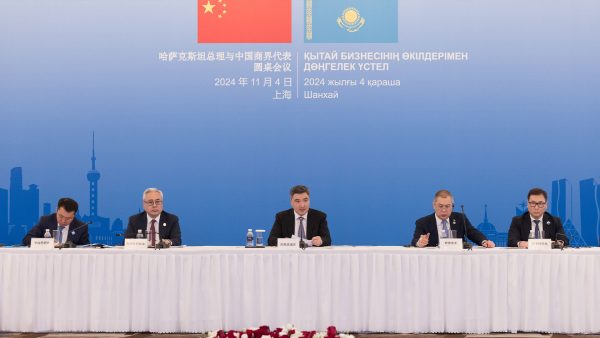Since Russia invaded Ukraine, Western countries have used sanctions as their primary means of penalizing Moscow, seeking to cut off flows of critical technologies to Russia’s defense industry. The current geopolitical situation has opened up detours and indirect trade routes through which dual-use goods from the West can find their way to Russia. Kazakhstan is a primary importer of dual-use goods from the West, and the rising trend that we are witnessing is that these goods are then being resold to Russia.
From January to October 2022, Kazakh companies exported electronics and mobile phones to Russia for over $575 million, 18 times more than that in the same period of 2021. At the same time, in 2022 Russia remained Kazakhstan’s largest trading partner, according to the Bureau for National Statistics (BNS) of Kazakhstan. This is part of a wider trend of back-door sales to Russia via third-party channels in neighboring or friendly countries, and Kazakhstan is one of them.
This indirect trade route is not a new phenomenon, but a well-versed one that emerged during the Cold War era with the creation of trade embargoes. Circumventing and finding alternative routes is an established practice in Russia. Given this, it comes as no surprise that these sanction evasion schemes are now appearing more on our radar and that Kazakhstan has become a popular choice for Russian manufacturers to access goods under export control.
According to the latest EBRD report, exports from the EU, U.K., and U.S. to Kazakhstan increased by more than 80 percent in 2022. At the same time, Kazakhstan increased its exports to Russia by more than 22 percent. What this tells us is that there is a significant uptick in intermediated trade, whereby goods are being exported to Kazakhstan and then sold onwards to Russia.
Previous research reports have highlighted that Russia’s weaponry heavily depends on specialist components manufactured abroad. These components can be grouped into two categories. The first is intermediate goods, which are parts and pieces that go into making final consumer goods, such as electronics, microchips, toasters, and medical equipment. The second category is capital goods, which are the machinery and equipment that are used to make other things, such as nuclear and machine-building equipment.
Both fall under the umbrella of dual-use goods, which are goods that have legitimate civilian and military applications. The many utilities of these goods have made them vague and difficult to control. Thus, identifying whether a good is arms-related or civilian is not always straightforward, and so each commodity has to be considered individually.
Key Challenges for the Western Exporter and the Kazakh Re-seller
The availability of prohibited trade flows from the West to Russia via Kazakhstan has prompted a new wave of export controls and sanctions to block the sale of critical items to Russia. On February 24, the United States, EU, and the United Kingdom announced a new package of sanctions on individuals and companies assisting Russia with sanctions evasion. Ukraine’s Western allies also warned of “severe costs” for countries helping Russia evade sanctions. A precedent for this was set back in June 2022, when the U.S. imposed secondary sanctions on an Uzbek company involved in exporting electrical components to Russia.
In most cases, exposure to sanctions risks up and down the supply chain may be less clear. These supply chain implications of the Russia-Ukraine conflict have caused many Western businesses to review their exposure to sanctions risk. So, for the Western exporter, the key challenge right now is trust. The recent rise in parallel trade has heightened the awareness of Russia’s prohibited trade practices in dual-use goods. Russia legalized parallel imports last year, and there is no specific legislation against parallel trade in Kazakhstan yet.
It’s important to remember that sanction evasion practices can happen at any stage of a trade transaction between the exporter and the seller. This adds a layer of difficulty in managing potential risks along the distribution channels: from sourcing materials and selling goods to the cities and ports along the shipping route, and the transit vessels themselves. For Western exporters, the risk of unintentionally having their products wind up in the Russian military and defense industries is high, and the sanctions risk would also be high.
These back-door sales to Russia won’t be abating any time soon. Equally, the logistical difficulties and the sharp prices of these indirect trade routes are not sustainable in the long term for intermediate traders. Thus, in the meantime, these well-oiled sanction evasion methods must be understood and anticipated before we can mitigate them.
For the Kazakh re-seller, the key risk they would face is secondary sanctions. In the last year, President Kassym-Jomart Tokayev has repeatedly offered assurances that Kazakhstan would comply with Western sanctions and that any trade interaction with Russia would be made in respect of the sanctions framework. This may not be a straightforward task for Kazakhstan for a couple of reasons.
Historically, Kazakhstan and Russia have been long-standing trading partners because they share the largest border and are members of the Eurasian Economic Union (EAEU), a free-trade zone alongside Belarus. In addition, routes used by local transport operators prefer the northern route to Europe, which goes through Russia, because it’s shorter and costs less.
For context, the transport infrastructure of Kazakhstan and Central Asia as a whole was heavily influenced by the needs of the former Soviet Union. In light of this, road and rail connections were designed to facilitate traffic flows toward the center of Russia in Moscow. Thus, this northern network via Russia is more well-developed compared to the connections with Kazakhstan’s eastern and southern neighbors. In addition, Kazakhstan’s membership in the EAEU has added to the favorability of the northern route for exports and doing business.
Many Kazakh traders have prospered under these sanctions thanks to the rising demand for cars, phones, and other machinery that they resell to Russia. This can also be seen in oil and coal exports. According to Kommersant, a Russian language news channel, with Kazakhstan, replacing Russian coal in Europe, the country increased its own coal exports through Russia in 2022 by 11 percent. Thus, Kazakhstan’s exposure to Russia economically, geographically, and politically is nothing new but should be understood and put in context.
Conclusion
Closing a back door on the sale of dual-use goods to Russia is no easy feat. Given that we live in an integrated economy and that global supply chains are made up of complex networks, you can’t punish every single actor involved in the network to remedy this problem. What we can do is attempt to mitigate the risks that can occur at various stages of a trade transaction. In order to do this, we must first understand how these supply chains work.
In the context of Kazakhstan, many variables make it a high-risk destination for parallel trade with Russia, the main ones being geography, economy, history, and politics. The economies of Kazakhstan and Russia have historically been closely related. Although rhetorically, Kazakhstan can provide assurances to the West that it will put regulatory pressure on the resale of critical goods to Russia, economically it’s not that straightforward.
At the same time, this problem presents several opportunities for Kazakhstan and businesses that have a level of exposure to the country. A possible upside for Kazakhstan could be a greater willingness to diversify its trade routes. For Western exporters of dual-use goods, an upside would be a greater strengthening of supply chain management and re-thinking best practices.
It will take a while for supply chains to recover and these prohibited trade practices won’t disappear overnight. With this in mind, business as usual is not an option anymore.




















Discussion about this post